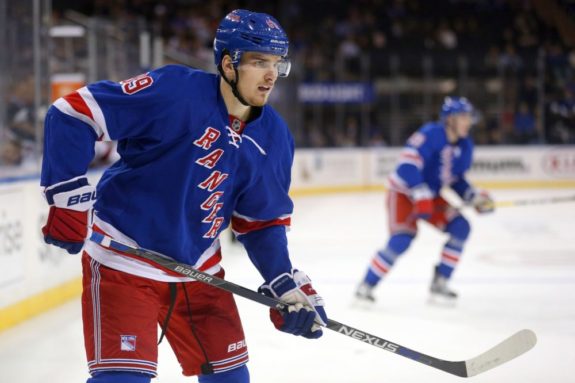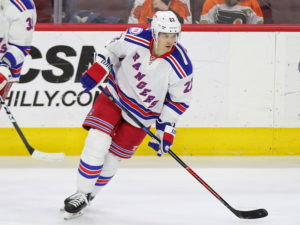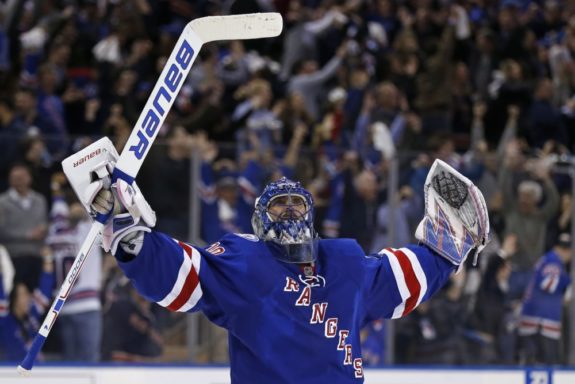The first round of the Stanley Cup Playoffs is behind us. There were some surprises, such as the Nashville Predators sweeping the Chicago Blackhawks, the Minnesota Wild bowing out in five games to the St. Louis Blues, and the Toronto Maple Leafs giving the Presidents’ Trophy-winning Washington Capitals a tough six-game series before finally falling.
A mild surprise was the New York Rangers taking down the Montreal Canadiens in six games, particularly after they fell behind two games to one. In the second round, the resurgent Rangers will take on another Canadian team in the Ottawa Senators, who dispatched of the Boston Bruins in six games as well.
The last time these two teams met in the postseason was in the first round in 2012, a heated and intense seven-game affair that saw the top-seeded Rangers squeak by the Sens. Much has changed since then, so this matchup should be fresh and interesting. An ongoing storyline will center around Mika Zibanejad of the Rangers and Derick Brassard of the Senators, as the two centers were traded for one another last offseason.
While the teams met three times this season, including a very recent contest on April 8, Senators fans might still benefit from an updated analysis of their second-round opponent, particularly since the Rangers dressed a far-from-optimal lineup April 8 in what was a relatively meaningless game for them.
The Rangers, despite playing with a lot of physicality against the Habs, are a team whose attack is predicated on speed and skill. That came to the forefront late in their first-round series victory against Montreal, as the insertion of rookie forward Pavel Buchnevich into the lineup gave the Rangers four skilled lines. The Habs could not match the depth of the Rangers’ skill, as the Blueshirts made the proper adjustments in addition to dressing Buchnevich and took control of the series after a rough Game 3.

While the Rangers’ game is primarily about speed and skill, they are not a strong puck possession team. In the regular season, they ranked just 25th in the league with a five-on-five Corsi-for percentage of 47.95 percent. Despite that, their style of play makes them a very dangerous team and among the very best in the NHL at creating offense via counterattacks and rush chances. This year, the Rangers got off to a torrid start offensively, routinely scoring four or five goals per game over the opening couple of months before coming back down to earth a bit.
Against Montreal, the Rangers adapted to the tight-checking nature of the games and managed to score when they had to, while veteran goaltender Henrik Lundqvist shook off a subpar regular season—especially by his standards—to emphatically turn the Canadiens aside. The King posted a 1.70 goals-against average and an absurd .947 save percentage in the six games. He also notched a shutout in Game 1 at the Bell Centre.
As a result of playing in the ultra-difficult Metropolitan division, the Rangers are not a typical wild-card team. They amassed 48 wins and 102 points in the regular season—both higher marks than the Senators. Nevertheless, the Sens will have home-ice advantage in the series after finishing as the No. 2 seed in the Atlantic Division.
The Rangers, though, who had the league’s best regular-season road record (27-12-2) and took two of three at the Bell Centre in the first round, will surely not be fazed by this. They come into this series riding a wave of confidence after three straight wins to close out the Habs, while the Senators have to be feeling similarly confident after defeating a tough, albeit depleted, Bruins team.
Rangers Forward Lines
The Rangers’ biggest strength is their forward depth. The array of skilled forwards on their roster gives them an advantage in that department over most teams they will see in the postseason, and it’s a big reason why they defeated the Canadiens in the first round. While they have four lines that can each be labeled, in reality, their lineup features something closer to three No. 2 lines and a very skilled and balanced fourth line. The Rangers didn’t have anyone among the league leaders in scoring during the regular season, but they ranked fourth in the league in goals per game—a testament to their balance.
First Line
The Rangers shook up their forward lines midway through their series against Montreal, coinciding with the insertion of Buchnevich. With no clearly-defined No. 1 line, the default is to look at which one Derek Stepan (jersey number 21) is centering. For the last few games of the first round, Stepan centered a line with Rick Nash (61) and rookie Jimmy Vesey (26).
The 32-year-old Nash was one of the Rangers’ best and most consistent forwards in the first round, notching two goals and one assist while being assertive and impactful in all three zones. With 11 points (five goals and six assists) in his last 13 postseason contests over the past few years, Nash is beginning to shake the somewhat unfair notion that he is not a good playoff performer. After finishing a good-but-not-great regular season strongly to end with 23 goals in 67 games, Nash appears to have taken that momentum into the playoffs, which bodes well for the Rangers.
Stepan, despite a prolonged goal-scoring drought earlier in the year, still put up 55 points, good for third-best on the team. He picked up two points in the first round, but more importantly, is a player who, like Nash, the Rangers can trust in all situations. While only 26 years old, Stepan has a wealth of experience already under his belt, having played in 91 career playoff games to date while posting 18 goals and 27 assists in those contests.
Vesey had somewhat of an up-and-down rookie campaign following all the hoopla around his signing with the Rangers, but managed to pot a respectable 16 goals in the regular season. While he has not yet found the back of the net in the postseason, he has picked up two assists, and his play has been very noticeable in a positive way. He appears primed to light the lamp very soon.
This trio did not play a ton of minutes together in the regular season, but they were on the ice together for over 223 minutes, during which time they played to a pedestrian five-on-five Corsi-for percentage of 49.89 percent. This was still better than the team’s mark as a whole, and the line helped the Rangers achieve the desired balance against the Habs.
Second Line
Beyond that line, the Rangers boast several more skilled lines, making them a difficult team to match up against. Once Buchnevich drew into the lineup against the Canadiens, head coach Alain Vigneault reunited a line that was dynamite for the Rangers early in the season but was broken up largely because of injuries.
The line features former Senator Zibanejad (93) centering Buchnevich (89) and Chris Kreider (20); it’s thus been dubbed the “KZB” line by Rangers fans. It’s no coincidence that Kreider and Zibanejad began to rediscover their games once they were placed with Buchnevich. Zibanejad had 14 goals and 23 assists in 56 games (he missed a large portion of time with a broken leg suffered in November), and came on late in the series against the Habs. He leads the Rangers in playoff points with four, the most memorable of which came in Game 5 in Montreal:
The 25-year-old Kreider enjoyed his finest regular season to date, registering 28 goals to lead the team, along with 25 assists. He struggled, however, for much of the opening round before the KZB line was reconstructed. He now appears to be finding his stride. If he plays his best, his unique combination of size, strength, and elite speed will be difficult for the Senators to handle.
Buchnevich, the Russian rookie who just turned 22, battled back problems and healthy scratches for much of the season, but still managed to put up an impressive 20 points (eight goals and 12 assists) in 41 regular-season games. While he did not find the scoresheet in his three games against the Habs, his positive effect on the KZB line and the Rangers’ lineup as a whole was palpable.
Third Line
Kevin Hayes (13) is the Rangers’ third-line center. He tallied 49 points (17 goals and 32 assists) in the regular season—not bad for someone in that position. Most recently, he has been placed between two of the Rangers’ leading scorers this season—Mats Zuccarello (36) and J.T. Miller (10). Zuccarello led the team with 59 points, including a career-best 44 assists. Miller meanwhile, had a career-high 56 points (22 goals and 34 assists).
This trio connected for a beautiful goal in the clinching Game 6 against the Canadiens. It exemplified the line’s traits of skill and tenacity. The goal, scored by Zuccarello off a great pass from Hayes, held up to be the game-winner.
Much like Kreider and Zibanejad, the shakeup of the lines seemed to provide a spark for Hayes and Miller, two players the Rangers need to rely on if they want to get past the Senators.
Fourth Line

The Rangers’ fourth line was supremely effective against the Habs. The underrated Oscar Lindberg brings excellent defensive awareness to the trio in addition to some offensive skill. Lindberg’s prowess as a two-way center was on full display in Game 5 against the Habs, where his five-on-five Corsi-for percentage was 100 percent (yes, you read that correctly). He was on the ice for 14 shot attempts for the Rangers, and zero for the Canadiens.
On Lindberg’s wings are Michael Grabner and Jesper Fast. Grabner proved to be a bargain free-agent signing for the Rangers, as he led them in goal-scoring for most of the season before hitting a wall late in the year. He finished the season with 27 goals, but only one of those came in the last 23 games. He did, however, score twice against the Habs. Beyond that, even when he is not scoring, Grabner gives the Rangers an elite speed element who can wreak havoc all over the ice, similar to ex-Ranger Carl Hagelin.
Fast is a very effective utility player who excels in a defensive role but can hold his own with offensive players if necessary. He is one of the Rangers’ best and most underrated forecheckers, as he is very adept at picking his spots to take the body and force turnovers, rather than just hitting players for the sake of being physical. He had a great series against the Habs, finding the scoresheet three times (two goals and one assist).
On Defense
The Rangers, who are fully healthy after battling some injuries in the latter part of the regular season, have a number of options they can deploy on defense. Unfortunately for them, none of those options masks the fact that the blue line is the team’s greatest weakness.
The bright spots on the back end are captain Ryan McDonagh (27), the Rangers’ do-it-all workhorse defenseman, and outstanding rookie Brady Skjei (76). McDonagh finished the regular season with 42 points (six goals and 36 assists) and led all Rangers skaters in ice time per game with an average of over 24 minutes. Skjei, who like McDonagh is a fantastic skater, has been solid all year and if anything, improved as the regular season progressed. Not only was he very sound defensively, but he also chipped in an unexpected 39 points (five goals and 34 assists). Against the Habs, he picked up two goals in the six games.
Trade-deadline acquisition Brendan Smith (42) has given the Rangers a nice combination of mobility, defensive awareness, and nastiness on the blue line. Beyond these players, though, things do not look too pretty.

Nick Holden (22) might look good on the surface with his great offensive statistics (11 goals, 23 assists), but just a bit of digging reveals some significant defensive flaws. Even less digging in the Montreal series reveals some glaring gaffes on defense, as he had a rough first round.
Marc Staal (18) has had a better season than he did a year ago, but that’s not saying much given the disaster that was his 2015-16 campaign. His trouble skating the puck out of trouble and propensity to go down on the ice prematurely often creates issues for the Rangers in their own zone. Other than a solid Game 4 against the Canadiens, he had a tough series as well.
On the right side, Dan Girardi (5) has been a warrior for the Rangers for years but sadly has been wholly ineffective for a couple of seasons now. The good news for the Rangers, though, is that he played some of his best hockey in a long time in the first round series. He was well-positioned, made good reads. He gave the Rangers all they can realistically hope for at this point.
Kevin Klein (8), meanwhile, has taken a major step back this year, becoming somewhat of a liability in his own zone. He played in one game (Game 3) in the first round after Holden was benched for his struggles, but Klein fared no better. Barring an injury, it’s unlikely Klein will see much if any ice time against the Senators.

For the Sens, the Staal-Holden defensive pair is one they can look to exploit with their speed. That pair has hemorrhaged shots while together this season, posting paltry possession metrics in over 600 minutes of ice time. Those struggled continued for much of the series against the Habs.
Adam Clendening (4) and Steven Kampfer (43) will serve as insurance policies on the roster. Even though inserting Clendening into the lineup would help the Rangers, there is no reason to believe they will, as they appear blind to what he can provide.
Defense is the Rangers’ weak link, as they rely on their offense and goaltending to cover up for their deficiencies on the back end. They were, however, able to get by the Habs with great play from McDonagh, Skjei, and Smith, and much-improved play from Girardi.
In Goal
The Rangers have historically been strong in goal with Henrik Lundqvist (30), but the 35-year-old Swedish netminder had somewhat of a tumultuous regular season while backup Antti Raanta (32) excelled when he took the net. The King, though, is now back in peak form after a dominant series against the Canadiens in which he outplayed the Habs’ Carey Price, who is generally thought of as the best goaltender in the league.

(Photo credit: Adam Hunger-USA TODAY Sports)
Lundqvist finished the regular season with the worst goals-against average (2.74) and save percentage (.910) of his career. While a lot of that is on him, the shaky defense attempting to support him does him few favors. Lundqvist routinely faces numerous high-danger and medium-danger scoring chances as a result of the Rangers’ weak defense corps.
This season, he actually performed well in stopping high-danger chances, doing so at a rate better than the average NHL goaltender. His downfall, however, was a below-average save percentage on medium-danger chances. Backup Antti Raanta, meanwhile, was solid in all areas.
Despite Raanta’s strong performance, Lundqvist is the guy for the Rangers, and his play so far this postseason has proven that. He is back to being the King, which gives the Rangers a chance against anyone.
Special Teams
The Rangers have had a roller-coaster of a year in both special teams departments. Their power play has alternated between hot and cold several times this season. After finishing the regular season hot, clicking at a 34.2 percent rate over the regular season’s final 15 games, the Rangers struggled with the man-advantage against the Habs, scoring just once in 15 attempts. They did, however, pick up that one power-play tally in the clinching Game 6, so perhaps another hot streak is imminent. For the entire regular season, the Rangers’ power play was 11th-best in the league with a 20.2 percent success rate.
McDonagh and Skjei man the point on the first and second units respectively. The right-handed Zibanejad provides a dangerous shot option from the left circle, while the hulking Kreider goes down low to create screens. Zuccarello often lurks around the side wall on the right side and leverages his strong passing abilities.
The penalty kill has been similarly tumultuous. Across the whole season, the Rangers’ killed off only 79.8 percent of opponents’ power plays, ranking them 19th in the league. Struggles late in the season brought them down, but they rebounded against the Habs, killing off 17 out of 20 penalties (85 percent).
The speed and playmaking abilities of players like Grabner, Hayes, Miller, Zibanejad, Fast, Stepan, and Nash make the Rangers a dangerous shorthanded team as well. The Rangers scored nine shorthanded goals in the regular season—tied for the sixth-most in the league. They also added one in Game 5 against the Canadiens.
In a nutshell, the Rangers have a strong forward corps and offensive attack, an unsteady defense, great goaltending (at least at this point in time), and volatile special teams. Still, they have enough weapons to be a tough matchup for the Senators if those weapons are all clicking simultaneously.
Note: Possession statistics obtained via Corsica.hockey unless otherwise noted or linked.